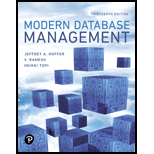
Pearson eText for Modern Database Management -- Instant Access (Pearson+)
13th Edition
ISBN: 9780137305940
Author: Jeffrey Hoffer, Ramesh Venkataraman
Publisher: PEARSON+
expand_more
expand_more
format_list_bulleted
Concept explainers
Textbook Question
Chapter 1, Problem 1.46PAE
Answer the following questions concerning Figures 1-18 and 1-19:
- What will be the field size for the ProductLineName field in the Product table? Why?
- In Figure 1-19 I, how is the ProductlD field in the Product table specified to be required? Why is it a required attribute?
- In Figure 1-19, explain the function of the FOREIGN KEY definition.
- In Figure 1-19, explain the purpose of the NOT NULL specification associated with ProductlD.
Expert Solution & Answer
Want to see the full answer?
Check out a sample textbook solution
Students have asked these similar questions
I need to define and discuss the uses of one monitoring or troubleshooting tool in Windows Server 2019. thank you
I would likr toget help with the following concepts:
- Windows Server features
- Windows Server versus Windows 10 used as a client-server network
I need to define and discuss the uses of one monitoring or troubleshooting tool in Windows Server 2019. thank you
Chapter 1 Solutions
Pearson eText for Modern Database Management -- Instant Access (Pearson+)
Ch. 1 - Prob. 1.1RQCh. 1 - Prob. 1.2RQCh. 1 - Prob. 1.3RQCh. 1 - Prob. 1.4RQCh. 1 - Prob. 1.5RQCh. 1 - Prob. 1.6RQCh. 1 - Prob. 1.7RQCh. 1 - How are relationships between tables expressed in...Ch. 1 - What does the term data independence mean, and why...Ch. 1 - Prob. 1.10RQ
Ch. 1 - Prob. 1.11RQCh. 1 - Prob. 1.12RQCh. 1 - Prob. 1.13RQCh. 1 - Prob. 1.14RQCh. 1 - Prob. 1.15RQCh. 1 - Prob. 1.16RQCh. 1 - Prob. 1.17RQCh. 1 - Prob. 1.18RQCh. 1 - Prob. 1.19RQCh. 1 - Prob. 1.20RQCh. 1 - Prob. 1.21RQCh. 1 - Prob. 1.22RQCh. 1 - Prob. 1.23RQCh. 1 - Prob. 1.24RQCh. 1 - Prob. 1.25RQCh. 1 - Prob. 1.26RQCh. 1 - Prob. 1.27PAECh. 1 - Prob. 1.28PAECh. 1 - Prob. 1.29PAECh. 1 - Prob. 1.30PAECh. 1 - Prob. 1.31PAECh. 1 - Prob. 1.32PAECh. 1 - Great Lakes Insurance would like to implement a...Ch. 1 - Figure 1-22 shows an enterprise data model for a...Ch. 1 - Prob. 1.35PAECh. 1 - Prob. 1.36PAECh. 1 - Prob. 1.37PAECh. 1 - Prob. 1.38PAECh. 1 - Prob. 1.39PAECh. 1 - Prob. 1.40PAECh. 1 - Prob. 1.41PAECh. 1 - Prob. 1.42PAECh. 1 - Prob. 1.43PAECh. 1 - Prob. 1.44PAECh. 1 - Consider the project data model shown in Figure...Ch. 1 - Answer the following questions concerning Figures...Ch. 1 - Prob. 1.47PAECh. 1 - Helen Jarvis wants to determine the most important...Ch. 1 - In this chapter, we described four important data...
Additional Engineering Textbook Solutions
Find more solutions based on key concepts
What types of polymers are most commonly blow molded?
Degarmo's Materials And Processes In Manufacturing
What is an uninitialized variable?
Starting Out with Programming Logic and Design (5th Edition) (What's New in Computer Science)
How does a computers main memory differ from its auxiliary memory?
Java: An Introduction to Problem Solving and Programming (8th Edition)
1.2 Explain the difference between geodetic and plane
surveys,
Elementary Surveying: An Introduction To Geomatics (15th Edition)
What types of coolant are used in vehicles?
Automotive Technology: Principles, Diagnosis, And Service (6th Edition) (halderman Automotive Series)
How are relationships between tables expressed in a relational database?
Modern Database Management
Knowledge Booster
Learn more about
Need a deep-dive on the concept behind this application? Look no further. Learn more about this topic, computer-science and related others by exploring similar questions and additional content below.Similar questions
- Please solve and answer the questions correctly please. Thank you!!arrow_forwardConsidering the TM example of binary sum ( see attached)do the step-by-step of execution for the binary numbers 1101 and 11. Feel free to use the Formal Language Editor Tool to execute it; Write it down the current state of the tape (including the head position) and indicate the current state of the TM at each step.arrow_forwardI need help on inculding additonal code where I can can do the opposite code of MatLab, where the function of t that I enter becomes the result of F(t), in other words, turning the time-domain f(t) into the frequency-domain function F(s):arrow_forward
arrow_back_ios
SEE MORE QUESTIONS
arrow_forward_ios
Recommended textbooks for you
 Database Systems: Design, Implementation, & Manag...Computer ScienceISBN:9781305627482Author:Carlos Coronel, Steven MorrisPublisher:Cengage Learning
Database Systems: Design, Implementation, & Manag...Computer ScienceISBN:9781305627482Author:Carlos Coronel, Steven MorrisPublisher:Cengage Learning Database Systems: Design, Implementation, & Manag...Computer ScienceISBN:9781285196145Author:Steven, Steven Morris, Carlos Coronel, Carlos, Coronel, Carlos; Morris, Carlos Coronel and Steven Morris, Carlos Coronel; Steven Morris, Steven Morris; Carlos CoronelPublisher:Cengage Learning
Database Systems: Design, Implementation, & Manag...Computer ScienceISBN:9781285196145Author:Steven, Steven Morris, Carlos Coronel, Carlos, Coronel, Carlos; Morris, Carlos Coronel and Steven Morris, Carlos Coronel; Steven Morris, Steven Morris; Carlos CoronelPublisher:Cengage Learning A Guide to SQLComputer ScienceISBN:9781111527273Author:Philip J. PrattPublisher:Course Technology Ptr
A Guide to SQLComputer ScienceISBN:9781111527273Author:Philip J. PrattPublisher:Course Technology Ptr- Np Ms Office 365/Excel 2016 I NtermedComputer ScienceISBN:9781337508841Author:CareyPublisher:Cengage


Database Systems: Design, Implementation, & Manag...
Computer Science
ISBN:9781305627482
Author:Carlos Coronel, Steven Morris
Publisher:Cengage Learning

Database Systems: Design, Implementation, & Manag...
Computer Science
ISBN:9781285196145
Author:Steven, Steven Morris, Carlos Coronel, Carlos, Coronel, Carlos; Morris, Carlos Coronel and Steven Morris, Carlos Coronel; Steven Morris, Steven Morris; Carlos Coronel
Publisher:Cengage Learning

A Guide to SQL
Computer Science
ISBN:9781111527273
Author:Philip J. Pratt
Publisher:Course Technology Ptr

Np Ms Office 365/Excel 2016 I Ntermed
Computer Science
ISBN:9781337508841
Author:Carey
Publisher:Cengage


dml in sql with examples; Author: Education 4u;https://www.youtube.com/watch?v=WvOseanUdk4;License: Standard YouTube License, CC-BY